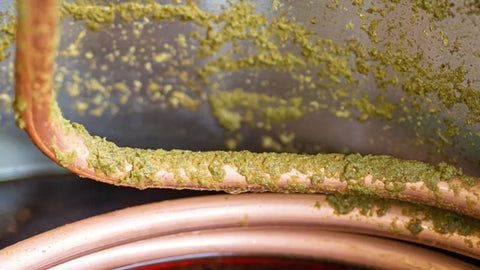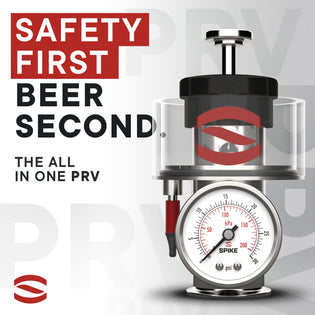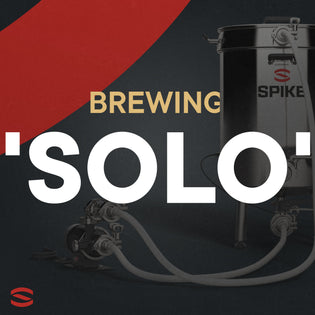By: Josh Rechek

Hi all, my name is Josh Rechek and I am the Head Brewer/ Production Maintenance Lead at MobCraft Beer Inc. in Milwaukee WI. I have been brewing with MobCraft Beer since 2015 and have over 10 years experience in the beverage industry. Before all of that, I worked in a homebrewing shop for a few years and have had a lot of fun in my own homebrewing adventures!

The topic of discussion is cleaning and sanitation; which is absolutely essential in every part of the brewing process. Improper cleaning and sanitation can lead to cross contamination of chemicals, flavors, or allergens. It can also lead to infections by unwanted organisms that negatively impact the flavor or shelf stability of the beer.
Left unchecked infections can become systemic throughout the brewery and become nearly impossible to get rid of. Luckily, in the brewing industry, the presence of alcohol in the finished product makes the risk of foodborne illness and pathogens very low. It’s highly unlikely you will ever make anyone sick with your beer, but without cleaning and sanitation, it might end up tasting downright awful.

Cleaning and sanitation isn’t exactly the most fun topic in the world and there is going to be a lot of dense information in this post. Just remember brewing should be fun; take it one step at a time, use common sense, and remember it's all for the pursuit of a tasty beer! Speaking of brewing, before we get started, check out this Spike Brew Day video at MobCraft!
Now let's get into the discussion...
What Is Sanitation?
What Is The Difference Between Sanitation And Cleaning?
Cleaning is the removal of soils from the surface of what is being cleaned. Soils can be any debris that is found on a surface including dust, food particulates, residual chemicals, water scale, or beer stone.
Sanitation is treating the cleaned surface to effectively kill any microbiological contaminants. A surface cannot be sanitized unless it is first cleaned. Soils can harbor microorganisms in places that the sanitizer cannot effectively reach, leading to ineffective sanitation.

The Importance Of Keeping Your Equipment Sanitized And Clean
Cleaning and sanitizing prevents the carryover of unwanted flavors, microorganisms, chemicals, and particulates. Essentially, the removal of anything that is not an intended ingredient in the finished product. Failure to properly clean and sanitize can lead to off flavors, reduced shelf stability, or even result in bodily harm to the consumer.
Every single part of the brewery should have a well laid out cleaning regimen. Whether you have some homebrew kettles in your kitchen or basement or run a large production brewer, it is worth taking the time to address every aspect of your brewing space. It should be evident that equipment like fermentation vessels, hoses, and fittings that touch beer must be clean and sanitized, but what about the environment around them?
Environmental sanitation is one of my biggest pet peeves. Is the floor clean? Is there dried beer caked to the wall from that carboy that blew off the airlock? What about that giant spot of black mold underneath where the hose always drips? If you take the time to address things like these, the rest of the process will be much easier for you and the people consuming your beer will taste the difference!
I also want to stress that cleaning and sanitation alone are not enough to ensure the production of quality beer. Proper preventative maintenance is also essential and oftentimes overlooked. Regularly inspect everything that is a food contact surface and replace any equipment that does not meet standards. Most equipment in the brewery will be either stainless steel or some sort of rubber good. Stainless steel is robust, but can have issues such as pitting, welds can get stressed and develop cracks or fissures, and it can even rust if brought into contact with a ferrous metal like mild steel. If properly cared for, stainless steel can last indefinitely.
Conversely, all rubber goods have a limited lifespan and will require periodic replacement. Common rubber goods in the brewery are manway gaskets, valve seats, tri-clamp gaskets, and pump seals. When rubber goods degrade they can no longer be cleaned and sanitized effectively, and become a nice home for all the little microbes you want to keep out. Over time rubber goods may become brittle, and begin leaving a residue, crack or tear. If you notice any of these signs it is time to replace them!

Basic Equipment You’ll Need
- Gloves- Thin nitrile or latex as well as waterproof/ heat resistant gloves. Always wear gloves when handling any cleaning chemicals! I highly recommend wearing gloves whenever you handle surfaces that come in contact with the beer. Even if you just washed your hands they are too dirty for making tasty beer.
- Rags- Effective at removing surface soils but must be washed between each use. I prefer not to use rags and strongly favor brushes whenever possible.
- Cleaning Brushes- A variety of brushes are needed to properly clean all equipment found in a brewery including tubing brushes, port brushes, and scrub brushes. Every brewing space is different and requires brushes that are properly sized to their function, so take some time and find brushes that work for your equipment. In a production environment bushes should be separated and color coded by zone of use. This includes specific brushes for product contact cleaning, product contact sanitizing, environmental cleaning, and floor drains.
- Cleaning And Sanitation Products- At a minimum, every brewing space needs at least 3 cleaning products; an alkali detergent cleaner, an acid cleaner, and a sanitizer. Alkali detergents are used for effective removal of organic material. Some examples are caustic soda, powdered brewery wash, or a foaming detergent. Acids are used for removal of inorganic materials such as beer stone or hard water scale. Some acid products include phosphoric acid, nitric acid, citric acid, or a blend of these acids as well as foaming acid-based products. A huge variety of sanitizers are commercially available and can be grouped by their mode of action; oxidizing and non-oxidizing. If used appropriately heat can also qualify as a sanitizer.
Types Of Contaminants
Physical
Physical contaminants are any physical particulates that end up in the beer. They can be just about anything including prior food residue, dust, oak barrel char, shards of pallet wood, hair, machinery hardware, etc. Physical contaminants are mitigated by detergent cleaning as well as good manufacturing practices such as wearing gloves, hair nets and keeping vessels closed whenever possible.
Chemical
This is almost exclusively related to residual cleaning chemicals. Once something is cleaned it is imperative that it is rinsed of all residual chemicals. If you want to validate a proper rinse the easiest way is by verifying the neutral pH of the spent rinse water.
Biological
Biological refers to any viable microorganisms that are not intended to be in the beer. Biological contaminants are mitigated by sanitation. Common biological contaminants in beer are Lactobacillus, Pediococcus, Brettanomyces type yeast, Acetobactor, and any brewers yeast that is not the intended strain for that product. Wild and sour beers are an exception to some of the aforementioned contaminants.
It also may seem silly to mention unintended brewers yeast, but cross contamination of yeast strains can have incredibly detrimental effects on a beer flavor and shelf stability. If you are curious about a specific example, do a little side research on diastaticus positive yeast.

Types Of Cleaning Agents Used
Powdered Brewery Wash

An effective, but less aggressive, alkali detergent cleaner typically containing weak bases such as Sodium percarbonate, sodium carbonate, and sodium metasilicate. It should also contain some sort of surfactant which breaks the surface tension of the water leading to a more effective clean.
Commercial examples are PBW cleaner, and Oxiclean (yeah the same stuff you might use for laundry). This is the primary cleaning chemical for homebrewers and for hand cleaning parts in commercial breweries because it is safer to handle than caustic soda.
Oxygen-Releasing Disinfectants
There are many commercially available disinfectants that use an oxidation reaction to kill microorganisms. These are typically very aggressive and must be handled with care. Care must also be taken to make sure these sanitizers are approved for use on stainless steel as some may cause surface degradation.
Some common oxygen releasing sanitizers include peracetic acid (PAA), several other variations of peroxy acids, and ozone. These sanitizers are not typically available to homebrewers due to their hazardous nature.
Non-Oxidizing Disinfectants
There several types of non-oxidizing disinfectants. Typically these are less aggressive and therefore more available to homebrewers. The two most common types used in brewing are acid based disinfectants like Star San or iodine based disinfectants like Iodophor. Isopropyl alcohol also makes a great disinfectant; though I do not recommend it to homebrewers as it is highly flammable.
Caustic Soda
Caustic Soda is simply Sodium Hydroxide. It is a strong base and therefore very aggressive. Caustic Soda is the industry standard for an alkali based detergent cleaner. It is typically not available to homebrewers. Caustic soda may be sold as dry beads or liquid solutions.
An effective caustic detergent should also contain a surfactant such as polyphosphate or EDTA to break the surface tension of the water for a more effective clean.
Acids
Common acid products are Phosphoric acid, nitric acid, citric acid, or a proprietary blend of these. Acid based cleaning products are used to remove mineral deposits such as water scale or beer stone (calcium oxalate).
Acids can also be used to passivate stainless steel. Passivation is the formation of a thin layer of chromium oxide on the surface of stainless steel, which is what gives this material its resistance to corrosion. If using an acid for passivation purposes, allow the stainless to completely dry exposed to air after the cleaning cycle is complete.

Brewery Equipment Cleaning Process
Manual Cleaning
This one is pretty straight forward, grab a bucket of powdered brewery cleaner solution (not caustic soda) and a brush and start scrubbing. Manual cleaning is used for environmental applications such as the exterior of tanks and for cleaning small parts such as sample valves and tri-clamp gaskets.
CIP
CIP means clean in place and refers to cleaning something without disassembly. CIP often uses a pump and a spray ball to recirculate a cleaning solution from the bottom of the vessel, through the spray ball mounted at the top of the vessel, and effectively reach every surface that beer will come in contact with. Please note that almost every vessel has some blind spots the spray ball can’t reach such as sample valve ports, racking arm ports, or manways. Even when performing a CIP procedure some hand scrubbing
of these hard to reach areas may be necessary. When performing CIP processes make sure to use cleaning and sanitizing products that are low or no foaming as excessive foaming can cause the pump to cavitate (lose prime).

COP
COP means clean out of place. This refers to cleaning of parts that must be removed to get a proper clean. On a commercial scale this involves a COP tank, which is a basin filled with cleaning solution where loose parts are placed and a pump provides agitation. In most instances homebrewers and even small scale breweries will use manual cleaning practices instead of a dedicated COP tank.
Foam Cleaning
Foam cleaning involves spraying a detergent solution that is injected with air inline to create a foaming action. The cleaner is sprayed on the equipment as a foam, allowed to sit, and then rinsed off with a hose. Foaming cleaners are well suited to clean the exterior of brewing vessels, packaging lines, walls, floors, and drains. This type of cleaning can be just as effective as manual cleaning with a brush, but requires far less labor.

Sanitation With Saniclean
Acid-Based Sanitizer
Pasteurization- heat! If implemented properly, this can be an effective form of sanitation for both equipment and the beer itself. Boiling wort is one example of this, it effectively kills microbial contaminants found in raw ingredients such as malt and hops. Larger breweries may also use pasteurization at the end of the brewing process either immediately before or after the beer is put into its final packaging (can, bottle, or keg). The absolute minimum guidelines for pasteurization is achieving 163F for 7 seconds. Heat is also effective for equipment such as the brewhouse vessels. Because of this, there is really no reason to ever use a chemical sanitizer on a mash/ lauter tun, boil kettle, or whirlpool vessel. For these vessels the boiling of the wort constitutes the sanitation step.

I want to focus on one piece of equipment in particular, the plate heat exchanger used for cooling the wort from the brewhouse on its way to the fermenter. This is the first piece of equipment on the ‘cold side’ of the beer making process and making sure it is sanitized is absolutely critical! Plate heat exchangers are notoriously hard to CIP due to the large amount of surface area and small pathways that the beer flows through. It is not feasible to disassemble and inspect between each use meaning there is no way to validate a proper clean on this type of equipment. If a piece of equipment isn’t clean, it can’t be sanitized with a chemical surface sanitizer. In this instance, the only way to ensure sanitation is heat, since it has the ability to penetrate through soils. At MobCraft Beer we recirculate hot water through our heat exchanger to sanitize and must maintain a temperature of 180F for 30 minutes prior to introducing the wort.
Brewery Equipment Cleaning And Sanitation Process
Step 1: Rinse. Thoroughly rinse the surface to be cleaned to remove as much soil as possible prior to introducing chemical cleaning agents. Hot water at high pressure is best!
Step 2: Alkali Detergent cleaning- clean the surface with an alkali based detergent cleaner at the proper concentration. There are 4 variables to cleaning; time, temperature, concentration, and force applied.
- Time; the detergent requires time to break down soils and release them from the surface being cleaned.
- Temperature; higher temperatures will make the detergent more reactive to the soils, up to the point the chemical is denatured. Generally speaking, the temperature of a cleaning solution should be 130-160F.
- Concentration; the proper amount of chemical must be present in the solution for an effective clean.
- Force; whether using a manual brush where your arm provides force or cleaning a tank with a sprayball where a pump supplies force, that force aids in the removal of soils.
All of these variables work together for an effective clean. A well laid out cleaning regimen will set standards for all of these variables. For example, a CIP regimen might look like this; recirculate caustic soda solution at a strength of 1% by titration at a temperature of 160 F through a spray ball for 30 minutes at a minimum pressure of 15 psi. A manual cleaning process might look like this; soak parts in a powdered detergent solution of 3 oz/gal at a temperature of 140F for 10 minutes. Remove parts and scrub with a brush.
Validating Chemical Concentrations: Always read the instructions carefully for your specific cleaning chemical and mix at the appropriate ratio. In a commercial setting, there are a few ways the concentration can be validated. A TDS meter is often used for measuring cleaning detergents in automated systems.
This gives you a good read of the concentration of cleaning chemicals but may be skewed by anything else dissolved in the cleaning solution.The best way to validate a cleaning chemical is by titration.
Alkali detergent is a basic solution and we can measure the concentration by using an indicator dye such as phenolphthalein and adding an acid such as HCl until the indicator dye causes a visible color change. The amount of acid required to cause the change in color directly correlates to the chemical concentration.
Step 3: Rinse Again; all residual cleaning chemicals must be removed. Alkali detergent cleaner will be slippery to the touch, rinse until the spent rinse water is no longer slippery or validate the spent rinse water has a neutral pH of approximately the same pH of the incoming water supply.
Step 4: Inspection; Visually inspect all surfaces and verify that they are visibly clean and free of soil. Use a flashlight if necessary and make sure to check all the hard to reach areas like ports, valves, and manways.
In a production brewery, the effectiveness of the clean may also be validated by an ATP meter (luminometer). A sample of the cleaned surface is taken with a sterile swab and inserted into the ATP meter. The meter exposes the sample to a bioluminescent chemical (the same chemicals that make fireflies light up) and the meter records how much light is produced. The amount of light produced directly correlates to the amount of organic matter on the swabbed surface.
Step 5: Acid Wash; Acid washing is not a necessary step every time you clean. It is recommended to perform an acid wash periodically, likely every 6 months, to remove mineral scale and beer stone buildup. If you have very hard water you may need to do this more frequently. The brewhouse vessels, especially the boil kettle, will likely require more frequent acid washing as well. Always read the instructions specific to the chemical you are using and follow the same guidelines as alkali detergent washing with regards to time, temperature, concentration, and force.
- The concentration of an acid solution can be measured by titration as well, but in the opposite direction. Add the indicator dye and titrate with a base such as NaOH until a color change is observed.
Step 6: Sanitize; Mix up a sanitizer solution per the recommended dosing rate and thoroughly coat the surface to be sanitized in the solution. Any approved sanitizer should effectively disinfect the surface within 30 seconds of contact time. It is always advised to exceed this time, especially in CIP applications, to be absolutely certain that all surfaces have been thoroughly coated in sanitizer solution. If possible, validate the concentration of your sanitizer. Sanitizers vary widely and therefore have different methods of validation, in most instances, it will be a color indicating test strip. Ask your chemical supplier (or homebrew shop) and they should be able to advise you.
Clean Up…with Spike!
Cleaning doesn’t always have to be a drag. Check out these guides and products below to make post Brew Day cleanup a breeze!

Looking at purchasing a system, Tank or OG kettle? Switch out a standard lid for a CIP lid for only $40!

FAQs
Can I use bleach to sanitize brewing equipment?
Absolutely NOT! While a highly effective sanitizer, bleach is aggressive and pits stainless steel. Over time pits in stainless steel will harbor microbes and make soils and residual cleaning chemicals more difficult to remove. In short, bleach makes anything made of stainless steel impossible to clean and sanitize. Bleach must also be rinsed so as not to impart any cross contamination and residual flavor into the finished beer. Whatever brewing sanitizer you choose, make sure it is suitable for a no rinse application.
What happens if you don’t sanitize brewing equipment?
All sorts of microbial infections can happen if you don’t sanitize. These infections can lead to off flavors and poor shelf stability in beer. Once an infection is established it is incredibly difficult to eradicate.
How often must you sanitize your brewing equipment?
All brewing equipment must be sanitized immediately before each use. Beer should never come in contact with an unsanitized surface until it is in the consumers mouth.
Do I have to clean and sanitize my equipment out of the box?
Absolutely! Equipment may have residual chemicals or oils as well as dust and debris from the manufacturing process. Even if the manufacturer is thoroughly cleaning equipment before shipping, it often gets dirty in the shipping and handling process. At MobCraft Beer any new equipment must be cleaned with an alkali detergent, an acid, and sanitized prior to it being put into service.
This post has covered all the essentials of cleaning and sanitation. I hope that it has shed some light on which cleaning chemicals you need, how to use them successfully, and even how these processes may differ from a homebrew setup to a full scale production brewery. Just remember, you don't need every piece of fancy equipment to produce good quality beer. The best tools in your arsenal are common sense, a lot of patience, and occasionally some elbow grease. Any professional brewer will tell you they spend exceedingly more time cleaning than actually producing beer. At the end of the day we are just overqualified janitors that occasionally make (and drink) some beer.

Starting in a homebrew shop Josh Rechek found his love for beer and turned it into a career. With over a decade of experience and thousands of batches under his belt he is still enjoying the creativity, community, and downright amazing beer that this industry offers. For those who want to taste for themselves, come on down to MobCraft Beer and enjoy a cold one. Cheers everybody!
About MobCraft Beer
MobCraft Beer was founded in 2013 by Henry Schwartz and Andrew Gierczak. It






